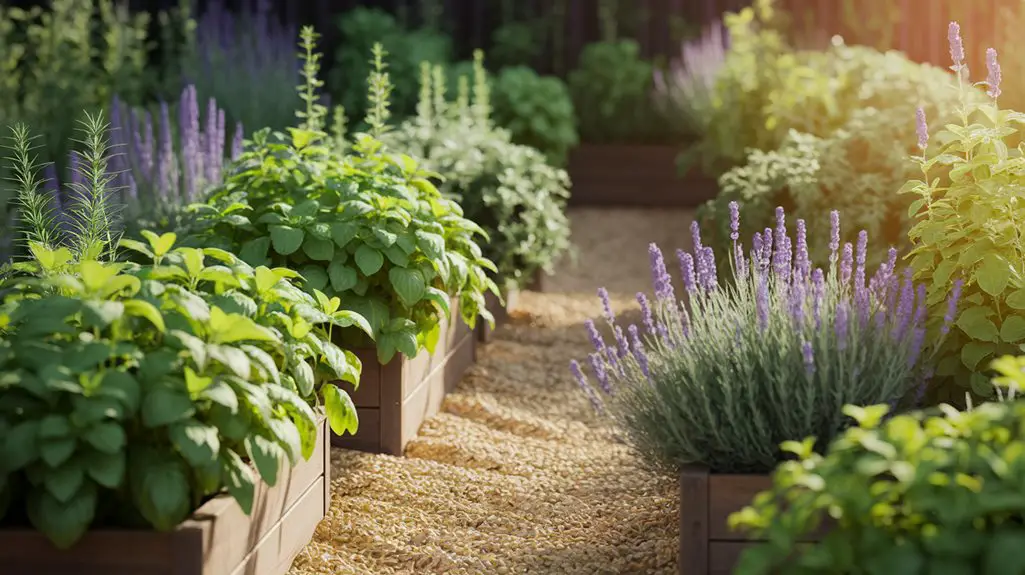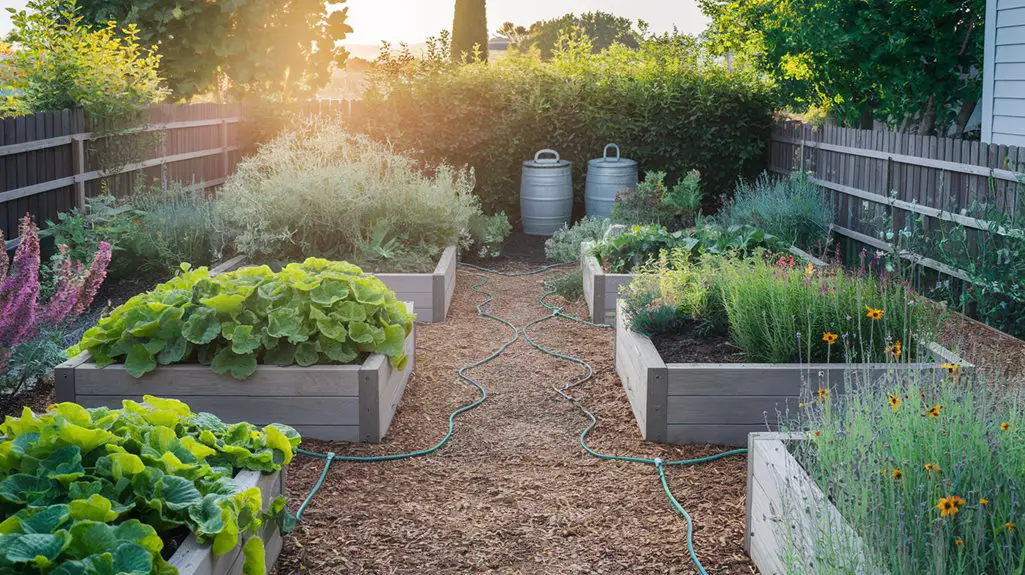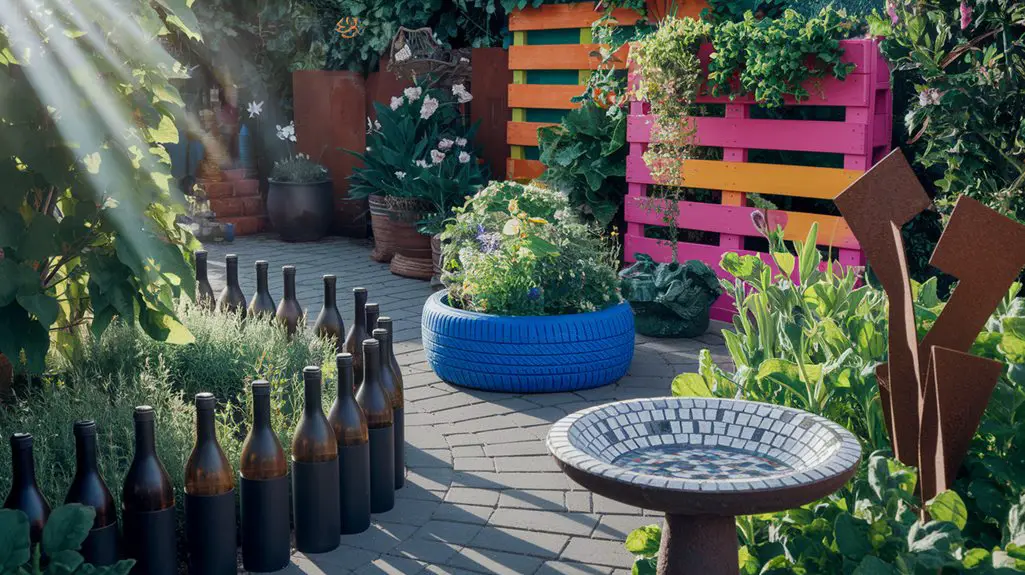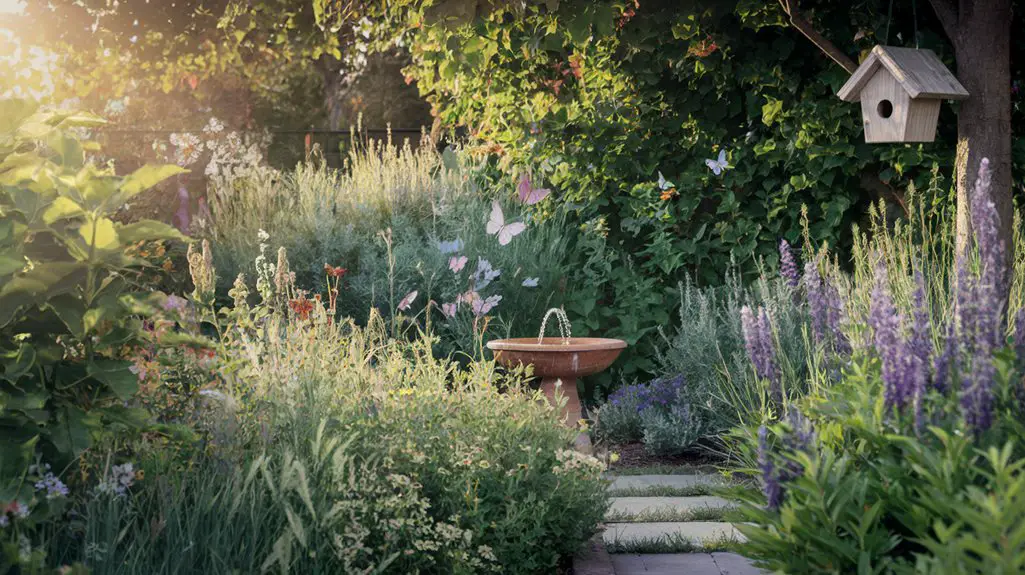Are you ready to transform that sun-drenched area of your yard into a productive herb garden? You'll need more than just a collection of pots to maximize growth and harvest potential. The right layout can mean the difference between mediocre and abundant yields from your culinary herbs. Strategic design also affects maintenance requirements, visual appeal, and space efficiency. Let's examine five proven configurations that harness full sun exposure while addressing common gardening challenges.
Tiered Herb Gardens for Maximum Sun Exposure
When designing a tiered herb garden for maximum sun exposure, consider the natural solar patterns of your growing zone and the specific light requirements of each herb variety.
Position your tiers on south-facing slopes or against south-facing walls to capture ideal sunlight throughout the day.
Construct stepped platforms with the tallest tier at the northernmost point, ensuring shorter herbs aren't shadowed by taller varieties. Space each level 12-18 inches apart vertically to prevent shading.
Mediterranean herbs like rosemary, thyme, and sage thrive on the uppermost tiers where they'll receive 6-8 hours of direct sunlight. Place mint, chives, and parsley on lower tiers where they'll benefit from partial afternoon shade.
Use light-colored stone or concrete for tier construction—these materials absorb heat during the day and radiate it overnight, extending your growing season. Additionally, incorporating herb garden ideas can help ensure the presence of beneficial insects that contribute to a thriving garden.
Spiral Herb Garden Designs for Small Sunny Spaces
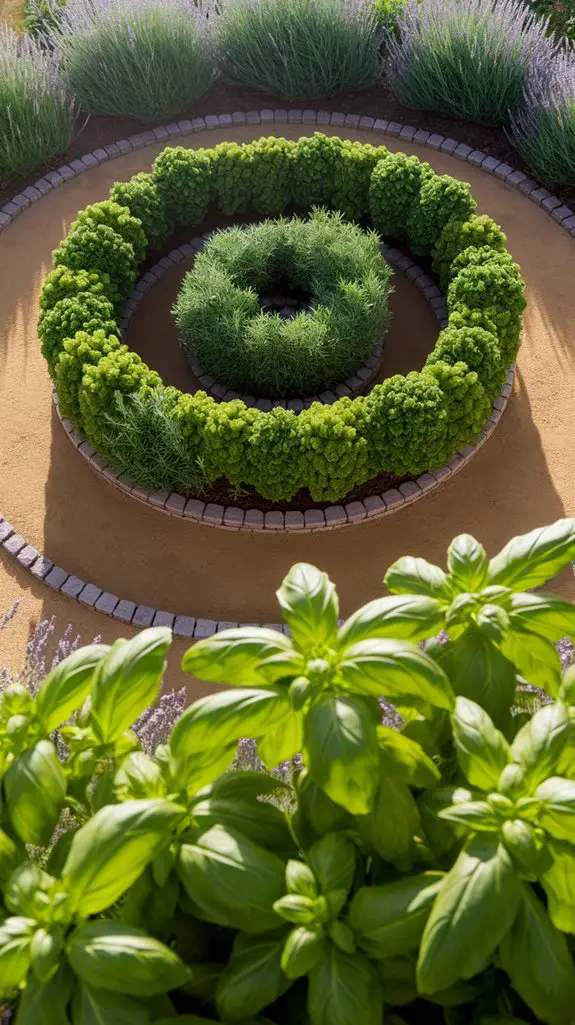
Spiral herb gardens offer one of the most efficient designs for maximizing sunlight exposure in compact spaces under 10 square feet. These vertical structures create multiple planting areas with varied sun exposures, allowing you to match herbs to their specific light requirements. Additionally, utilizing raised garden beds can enhance soil quality and drainage, further benefiting your herb garden.
When constructing your spiral, position sun-loving Mediterranean herbs like rosemary and thyme at the top southern side, while placing shade-tolerant varieties toward the bottom northern edge.
| Plant Position | Full Sun Herbs | Partial Sun Herbs |
|---|---|---|
| Top (South) | Rosemary, Sage | Oregano, Marjoram |
| Middle | Thyme, Savory | Basil, Chives |
| Bottom (North) | Lavender | Parsley, Mint |
For best results, use stones or bricks that absorb daytime heat, creating beneficial microclimates that extend your growing season while providing excellent drainage for Mediterranean herbs that detest wet feet.
Container-Based Herb Gardens for Sunny Patios

Container-based herb gardens offer flexibility and accessibility for sunny patio spaces where in-ground planting isn't feasible.
Select containers with minimum 6-inch depth and adequate drainage holes to prevent root rot. Terra cotta pots heat quickly, benefiting heat-loving herbs like rosemary and thyme, while glazed ceramics retain moisture better for basil and mint.
Position containers to maximize sunlight exposure (6-8 hours daily), placing sun-demanding herbs like sage and oregano in the brightest spots.
Consider height gradation, with taller herbs like fennel positioned northward to avoid shading shorter varieties.
Implement a drip irrigation system with timers for consistent moisture, as containers dry faster than ground soil.
Group herbs with similar water requirements together—drought-tolerant Mediterranean varieties in one cluster, moisture-loving herbs in another. Additionally, raised bed herb gardens can also enhance your gardening experience by providing defined spaces for organized growth.
Mediterranean-Style Herb Garden Layouts

While originating from the sun-drenched landscapes of Greece, Italy, and southern France, Mediterranean-style herb garden layouts excel in any sunny location with well-draining soil.
Design your space with gravel pathways between planted beds to enhance drainage and reflect heat upward onto plants. Position rosemary, lavender, and thyme at the garden's perimeter as natural borders, while oregano and marjoram form middle-ground plantings.
Incorporate structural elements like terracotta pots, limestone borders, and small olive trees as focal points. You'll want to create planting zones based on water requirements—group drought-resistant herbs like sage separately from more water-demanding basil.
For authenticity, include a central feature such as a sundial, small fountain, or rustic wooden bench. This practical arrangement guarantees ideal growing conditions while capturing the Mediterranean aesthetic's informal elegance. Additionally, consider the benefits of culinary-inspired herb gardens to enhance the flavors of your dishes.
Raised Bed Herb Garden Configurations for Full Sun

Raised bed configurations offer significant advantages for herb gardening in full-sun locations, building upon the drainage benefits seen in Mediterranean designs. You'll find these structures particularly effective when arranged to maximize southern exposure while creating microclimates within your garden space. For ideal herb productivity in raised beds, consider these configurations:
- Tiered rectangular beds (tallest at north) that prevent taller herbs from shading smaller varieties
- Circular mandala designs with herbs arranged by water requirements—drought-tolerant varieties at the crown, moisture-loving herbs at lower edges
- Keyhole configurations that maximize planting space while minimizing walking paths
- Grid-based companion planting layouts that group herbs with similar light and water requirements
When constructing raised beds, use untreated cedar or redwood for longevity and maintain 12-24 inch depth. Additionally, container vegetable gardening can complement your herb garden by allowing for versatile planting options in sunny areas.
Conclusion
You've now got five powerful layouts to harness the sun's energy for your herbs. Whether you're adapting to a sloped yard, maximizing limited space, or creating a Mediterranean microclimate, these designs enhance light exposure while meeting your herbs' specific needs. Remember, "the early gardener catches the thyme"—thorough planning now will guarantee your garden thrives throughout the growing season. Implement proper irrigation and companion planting strategies within your chosen configuration for peak yield.

